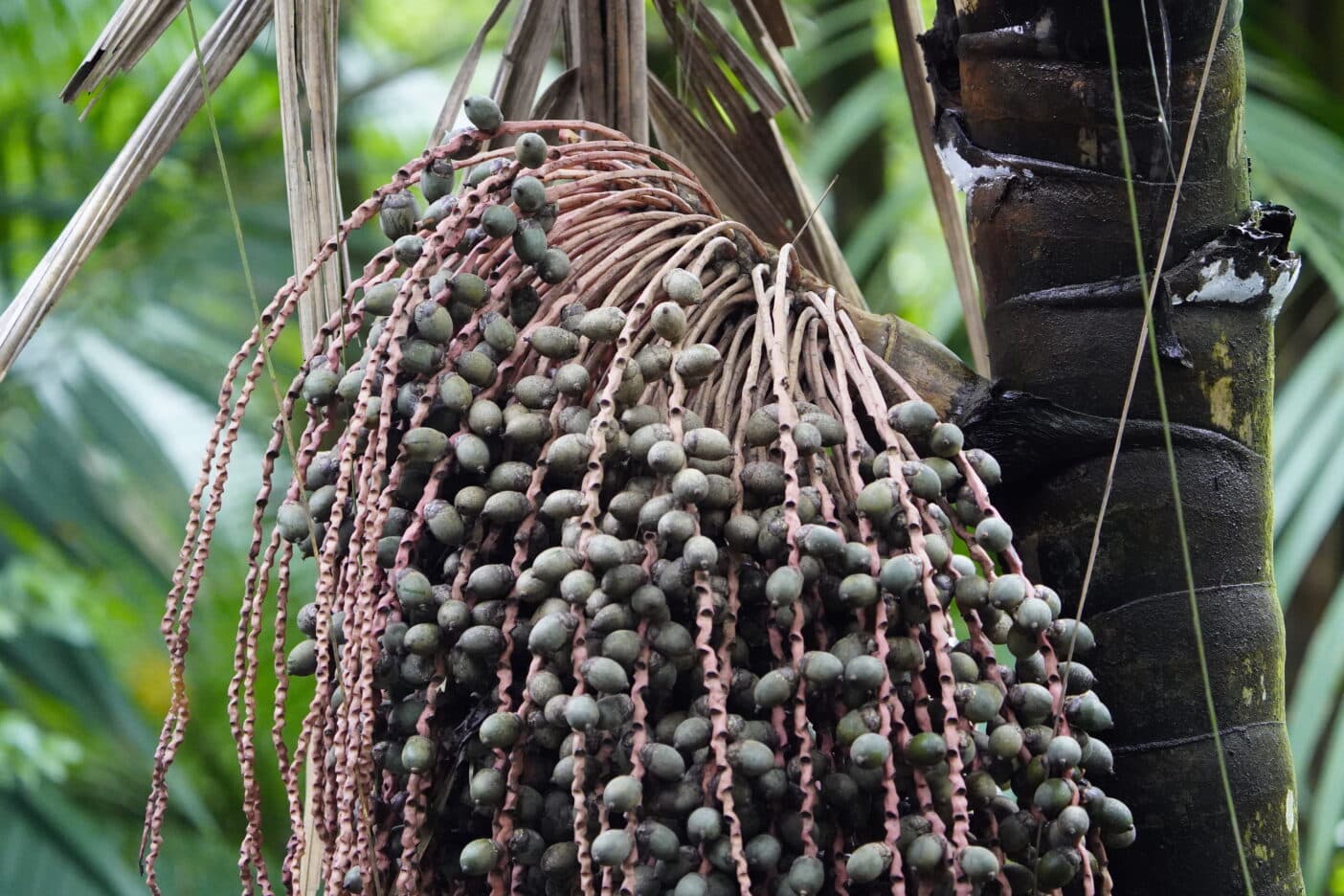Patauá oil

The Patauá palm is native to the Amazon region and source of Patauá oil. There it grows in dry forests and swampy areas. The solitary trunk reaches a diameter of up to 30 cm and a height of 25 meters.
Also called Patawa and locally Ungurahui, the tree yields edible fruits and an amazing oil. Fruits of patauá palm are collected in the Amazon, mainly on riverbanks, and are slightly larger than olives.
The indigenous population soaks the fruits in lukewarm water to prepare drinks and extract oil. The so-called Patauá wine is a milky, chocolate-like drink. It is even given to infants as a substitute for breast milk. In fact, the dried fruit pulp contains 7.4% protein and has an amino acid profile similar to cow’s milk.
Locals use the oil like olive oil, cold or hot and for frying, while in the Western world it is considered a gourmet oil.
The pulp is also used in ice cream, skin care, and hair oil, and is the secret to the shiny hair of Amazonian Indians. In folk medicine, the infusion of leaves helps with coughs, bronchitis and all inflammations of the respiratory tract.
The branches are used to make arrows, the leaves are used to make baskets, and the stems are used as building material.
Extraction of Patauá oil
In traditional oil extraction, the fruit pulp, previously separated by soaking in water, is brought to a boil in containers until the oil rises to the surface and can be skimmed off.
More gentle is the mechanical process, which is ideally done at room temperature and with a screw press. With mechanical pressing, a palm tree can yield about 2.5 liters of oil/year.
The company Beraca, specialist in certified active ingredients for cosmetics (Ecocert, Cosmos, USDA Organic, Organico Brasil, Euro-Bio label) from the Amazon rainforest, offers Patauá oil both refined and unrefined. While the refined oil convinces with its sensory properties and feels light on the skin, has a pale yellow-greenish color and almost no odor, the unrefined variant scores with a slightly higher active ingredient content.
Valuable substances in Patauá oil
The Patauá fruit consists of 40% pulp and 60% seeds. The pulp contains about 18% oil.This oil has a similar fatty acid profile to olive oil, but is softer and has a fruitier taste.
It has a saturated/unsaturated fatty acid ratio of 16:84.
Oleic acid (omega 9) 68-83%.
Palmitic acid 6-15%
Stearic acid 2-9.5%
Linoleic acid (omega 6) 2-9%
α-linolenic acid < 5%
Palmitoleic acid < 2%
Of note is the amino acid composition, which is similar to breast milk or cow’s milk or beef.
The following amino acids are included: Asparagine, glutamine, alanine, histidine, arginine, isoleucine, leucine, lysine, methionine, cysteine, phenylalanine, tyrosine, threonine, valine, tryptophan.
In addition, the plant is rich in antioxidants, such as anthocyanins and alpha-tocopherol, as well as Δ5-avenasterol, campesterol, oleanolic acid derivative, hydroxycinnamic acids.
Not only the berry also the leaves and roots provide antioxidants.
The article “Oenocarpus babacea and Oenocarpus bataua leaflets and roots: a new source of antioxidant compounds” (2016) reports that the effect of Patauá leaves and roots is based on radical-scavenging activity at the cellular level.
In leaves, it is mainly flavonoids from C-glycosyl apigenin derivatives, while hydroxycinnamic acids are found in leaves and roots: Caffeoylquinic acid in leaves and caffeoylshikimic acid in roots.
This provides a non-cytotoxic source of antioxidants for use in pharmaceuticals and cosmetics.
Significance for cosmetics
With its unique amino acid profile, Patauá oil provides valuable building blocks for skin and hair. The amino acids have a moisturizing and water-retaining effect. Thanks to their buffering effect, they stabilize the skin’s protective acid mantle.
Due to its fatty acid profile, Patauá oil is quickly absorbed, is not greasy and does not leave a greasy sheen on the skin. Omega 9 has a refatting effect, is well tolerated by dry skin and dry scalp.
Palmitic acid is recommended for skin care as a component of the skin barrier and hydro-lipid film. Linoleic acid prevents excessive transepidermal water loss, cornification disorders, improves skin barrier regeneration, is a building block of ceramide I and moisturizes the skin.
In addition, there are the antioxidants that are interesting in anti-aging care, not forgetting the qualities for hair care.
Patauá oil in hair care:
Tonic for hair, to prevent hair loss, supports hair growth (strengthens and moisturizes hair follicles), hair care oil, hair masks, styling products.
Patauá oil for the scalp:
Anti-dandruff effect, against scabs, regenerates scalp.
Patauá oil in skin care:
Face cleanser, face oil, face masks, eye/lip cream, body care.
We have also discovered Patauá oil in volumizing mascara and its use for beard care is also conceivable.
Disadvantages
It is important to look for pure oil, preferably food-grade and organically grown or sustainably wild-collected, to take advantage of the full active ingredient content.
A sustainable origin ensures that the oil is not stretched or diluted with other oils and does not contain pesticides, bactericides, insecticides.
Profile: Patauá oil
INCI: Oenocarpus Bataua Fruit Oil
CAS number: 1938910-14-5
Description: vegetable fruit oil
Origin: Brazil
Production: cold pressing
Storage: cool, dry, protected from light
Storage temperature: 14 – 18°C
Shelf life: unopened 14 – 18 months
Ingredients: Oleic acid (omega 9), palmitic acid, stearic acid, linoleic acid (omega 6), amino acids, antioxidants
Effects: strengthens scalp health, reduces dandruff, adds shine, hydrates without greasy feeling, strengthens hydro-lipid film and skin barrier
Uses: Hair care, scalp, facial and body skin.
Hair and skin care from the Amazon rainforest
The Amazon rainforest offers a cornucopia of interesting active ingredients. The Patauá palm surprises with the unique amino acid content of its oil. This makes it ideal for nourishing, strengthening and regenerating hair and skin care. If attention is paid to the careful extraction and purity of the oil, a gourmet oil ends up in cosmetics, resulting in facial oils, anti-aging creams, high-quality natural cosmetics and hair care for beautiful, non-greasy shine. Cosmacon will be happy to advise you on the best raw material and formulation for your products.
Literature:
Oenocarpus bacaba and Oenocarpus bataua Leaflets and Roots: A New Source of Antioxidant Compounds.
Leba LJ, Brunschwig C, Saout M, Martial K, Bereau D, Robinson JC.Int J Mol Sci. 2016 Jun 27;17(7):1014
Roumy V, Gutierrez-Choquevilca AL, Lopez Mesia JP, Ruiz L, Ruiz Macedo JC, Abedini A, Landoulsi A, Samaillie J, Hennebelle T, Rivière C, Neut C.Pharmacogn Mag. 2015 Oct;11(Suppl 4):S625-33
Cardona Jaramillo JEC, Carrillo Bautista MP, Alvarez Solano OA, Achenie LEK, González Barrios AF.Biomolecules. 2019 Aug 1;9(8):329
